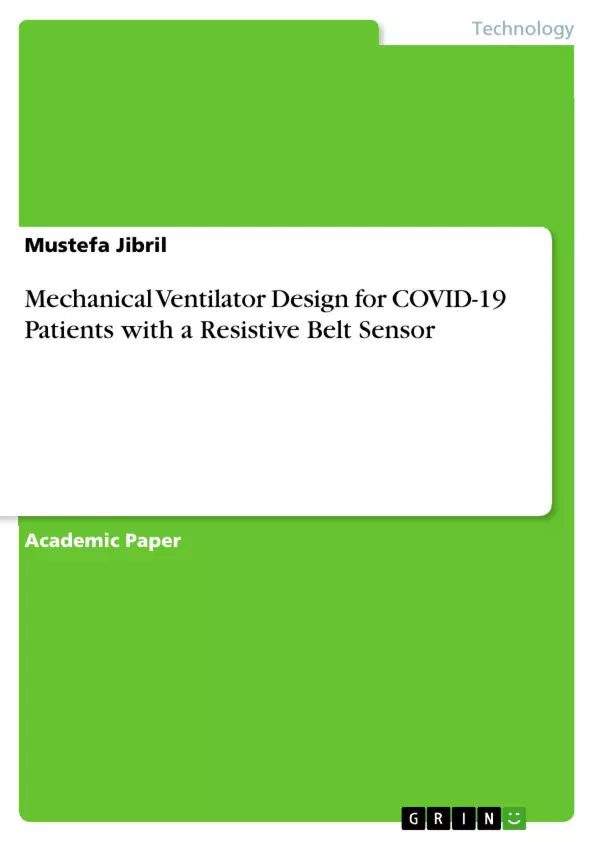A ventilator is a device that provides cool air by moving the air in or out of the lungs, inhaling a patient who is not fit to smell, or breathing properly. In this paper, a resistive chest belt sensor-based mechanical ventilator is designed to provide the COVID-19 patient with the volume of air you need to deliver with the expansion of the patient's chest in need of more air. The resistive band sensor senses the expansion of the patient's chest and controls the solenoid valve attached to the oxygen compressor. The function of the respirator is tested with the MATLAB/Simulink tool with the help of a Proportional Integral Derivative (PID) Controller and a promising result obtained.
Inhaltsverzeichnis (Table of Contents)
- Introduction
- Mathematical Modelling
- How is it work
- Resistive Sensor Chest Belt
- Resistive Belt Modeling
- Modeling of the Solenoid Valve
- Tidal Volume (TV)
- Ventilator Air Duct Design
- Proposed Controller Design
- PID Controller
- Result and Discussion
- System Parameters
- Simulink Block Diagram
- Simulation of the Actual Belt Resistance to Reference Resistance with Patient Normal Breathing
- Simulation of the Actual Belt Resistance to Reference Resistance with Patient Sudden Air Volume Inhale
- Conclusion
Zielsetzung und Themenschwerpunkte (Objectives and Key Themes)
This paper presents the design of a resistive chest belt sensor-based mechanical ventilator specifically tailored for COVID-19 patients. The ventilator aims to provide patients with the necessary air volume by sensing the expansion of their chest, thereby controlling the solenoid valve connected to the oxygen compressor. The system's functionality is tested using MATLAB/Simulink, incorporating a Proportional Integral Derivative (PID) Controller to achieve promising results.
- Design and implementation of a resistive chest belt sensor-based mechanical ventilator.
- Application of the ventilator for COVID-19 patients.
- Control of air volume delivery based on patient chest expansion.
- Integration of a PID controller for system optimization.
- Simulation and analysis of the ventilator system using MATLAB/Simulink.
Zusammenfassung der Kapitel (Chapter Summaries)
- Introduction: The paper begins by introducing the concept of mechanical ventilators, their applications, and the design challenges associated with ensuring patient safety and effectiveness. It discusses the evolution of ventilators, from basic hand-operated devices to sophisticated electronically controlled systems. The need for careful design to prevent complications and ensure adequate air delivery is highlighted.
- Mathematical Modelling: This section delves into the detailed modeling of the ventilator system, including the resistive chest belt sensor, the solenoid valve, and the tidal volume. It explains how the belt sensor detects chest expansion and controls the air volume delivered by the solenoid valve, which is connected to the oxygen compressor. The relationship between patient breathing, belt resistance, and air volume is discussed.
- Proposed Controller Design: This section outlines the design of the PID controller, which plays a crucial role in regulating the air volume delivered to the patient. The PID controller utilizes feedback from the chest belt sensor to ensure optimal air delivery.
- Result and Discussion: This section focuses on the simulation results obtained using MATLAB/Simulink. It covers system parameters, the Simulink block diagram, and simulations illustrating the ventilator's response to varying patient breathing patterns. This section provides evidence of the system's effectiveness in delivering the required air volume based on patient needs.
Schlüsselwörter (Keywords)
This paper focuses on the design of a mechanical ventilator utilizing a resistive chest belt sensor for COVID-19 patients. Key terms include: Ventilator, Resistive, Proportional Integral Derivative (PID), and COVID-19. The study investigates the application of a PID controller in regulating air volume based on patient chest expansion, utilizing MATLAB/Simulink for simulation and analysis.
- Quote paper
- Mustefa Jibril (Author), 2021, Mechanical Ventilator Design for COVID-19 Patients with a Resistive Belt Sensor, Munich, GRIN Verlag, https://www.hausarbeiten.de/document/1127990


